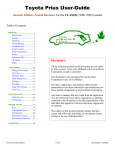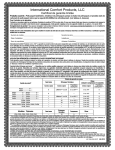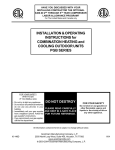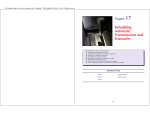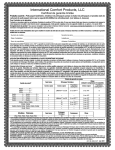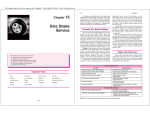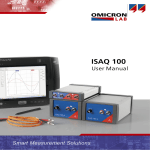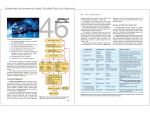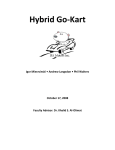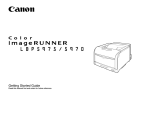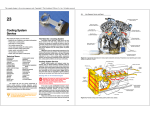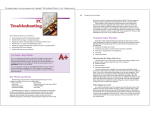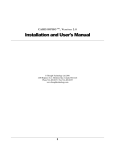Download Chapter 38 - Goodheart
Transcript
This sample chapter is for review purposes only. Copyright © The Goodheart-Willcox Co., Inc. All rights reserved. 38 Hybrid Drive System Operation and Repair After studying this chapter, you will be able to: Identify the major parts of a hybrid drive system. Explain the construction and operation of hybrid drive assemblies. List the safety measures that must be followed when working on high-voltage hybrid drive systems. Use on-board diagnostics to find the source of problems in a hybrid vehicle propulsion system. Identify the most common problems that occur in a hybrid vehicle drive system. Perform basic tests to verify hybrid drive trouble codes. Safely remove and replace a hybrid battery pack, power control module, power cables, ECUs, and motor-generator assemblies To identify a hybrid vehicle, look for badging on the front fender, engine cover, or hood. You can also compare the vehicle’s VIN (vehicle identification number) to factory reference information. The 5th, 6th, and 7th alphanumeric characters in the VIN identify hybrid vehicles. Hybrid Vehicle History In 1898, Ferdinand Porsche, the founder of Porsche Motor Car Company, designed and built a car that used a small internal combustion engine to spin a large electric generator. The generator was then used to power electric motors at each drive wheel. No clutch, transmission, or Internal combustion engine Introduction A hybrid vehicle (HV) uses two individual power sources to provide energy for propulsion. A hybrid gas-electric vehicle (HGEV) has an internal combustion engine and an electric drive system combined into one vehicle power train. See Figure 38-1. Since hybrid gaselectric vehicles are now produced and sold by many automakers, it is important that you understand how these vehicles operate and the methods for safely servicing them. The electrical/electronic service methods you learned in previous chapters apply to hybrid vehicles. The primary concern when working on a gas-electric hybrid drive train is the extremely high voltage and current stored and generated by the electric drive devices and circuits. Besides the gas-electric hybrid, automakers are experimenting with fuel-cell hybrids, hydraulic hybrids, and pneumatic hybrids. However, none of these experimental drive systems are presently being mass produced and used in passenger vehicles. 694 Motor-generator Figure 38-1. An internal combustion engine and a powerful electric drive train are used to propel a hybrid gasoline-electric vehicle. (Honda) Chapter 38 Hybrid Drive System Operation and Repair mechanical drive train was used. This first hybrid had large wires between the generator and the drive motors. The same basic principle is used today in large locomotives. A locomotive uses a large diesel engine to spin an electrical generator. The generator can then energize one or more large electric traction motors that turn the locomotive’s wheels. Advances in electric motor and battery technology have allowed automakers to build hybrid vehicles that accelerate as well as conventional gasoline-powered vehicles while reducing the amount of fuel burned in both city and highway driving. Hybrid vehicles now have the highest combined average fuel economy numbers of any type of mass-produced passenger vehicle. Hybrid Drive Vehicle In a gas-electric hybrid, the internal combustion engine and electric drive system work in unison under computer control to propel the vehicle and operate its electrical accessory systems. There are six major assemblies in a gas-electric hybrid drive system, Figure 38-2. • High-voltage (HV) battery pack—large number of voltaic cells wired in series to produce a highvoltage, high-power storage battery. • Μotor-generator—armature and stator assembly that can function as a high-power motor or a highpower generator. • Power control module—high-voltage electronic circuit that can change dc to ac or ac to dc. It can also amplify or reduce voltage. • Hybrid drive ECU—electronic control unit that monitors driving conditions to help control the operation of the power control module, battery pack, and motor-generator. • Power cables—large insulated conductors that electrically connect the battery pack, power control module, and motor-generator assemblies together. • Ιnternal combustion engine—gasoline or diesel engine that propels the vehicle at highway speeds and spins the motor-generator armature to recharge the battery pack. A conventional fuel tank, fuel lines, and electronic fuel injection system feed gasoline or another fuel to the internal combustion engine. As mentioned, the internal combustion engine is capable of propelling the vehicle and providing energy to spin the motor-generator to recharge the battery pack. The motor-generator can also be used to propel the vehicle and help slow the vehicle when the brakes are applied. Both the motor-generator and the engine work together to provide a dependable and fuel efficient means of transportation. 695 Hybrids Types Hybrid vehicles can be broadly grouped into two categories, full hybrids and mild hybrids. A full hybrid uses the motor-generator to initially accelerate and propel the vehicle; the internal combustion engine only runs when the battery pack becomes discharged. Full hybrids can accelerate normally (not full throttle) without consuming any fuel or emitting any exhaust emissions. The full hybrid is propelled by the motor-generator until the HV battery pack has about a 30% charge remaining. Then the hybrid drive ECU “fires up” the internal combustion engine to propel the vehicle and recharge the HV battery pack. A mild hybrid is propelled by its internal combustion engine only. This type of hybrid shuts down its engine when the vehicle is coasting, braking, or stopped. It then uses a large starter-alternator to quickly restart the engine when the brake pedal is released. The starter-alternator functions as an alternator when the engine is running. Most mild hybrids have a 36- or 42-volt electrical system that powers electric motors to drive accessory items, such as the power steering pump or the air conditioning compressor. In this way, these components continue to work even when the internal combustion engine is shut down. Engine/body ECU Hybrid drive ECU Fuel tank Internal combustion engine Battery pack Power cables Power control module Motorgenerator 3-phase power cables Figure 38-2. The major assemblies of a typical gasoline-electric hybrid are shown here. The electric drive train primarily operates at low vehicle speeds. The internal combustion engine operates at higher engine speeds or when the battery pack becomes discharged. 696 Section 5 Electrical Systems Chapter 38 Hybrid Drive System Operation and Repair Note! A few mild hybrids use a small motor-generator to assist the gas engine in accelerating from a standstill to about 10–20 miles per hour. This improves fuel economy slightly but not as much as the full hybrid drive train. Battery pack Power control module Generator Hybrid Drive Train Configurations Hybrids are often classified by the configuration of their drive train. A series hybrid has a separate generator and traction motor. It does not use a motor-generator. In a series hybrid configuration, the traction motor is the only method used to apply torque to the vehicle’s drive train. The internal combustion engine has no mechanical connection to the drive train. At least one major auto manufacturer is developing a series hybrid for mass production. This is illustrated in Figure 38-3A. The series hybrid can operate in the all-electric mode when the battery pack charge is sufficient to propel the vehicle. When the battery pack becomes drained, the internal combustion engine starts and turns the generator to recharge the battery pack. A parallel hybrid uses both an internal engine and a motor-generator to apply mechanical torque to the drive train. The engine and motor-generator operate in parallel, or at the same time. See Figure 38-3B. During rapid acceleration, both the engine and the motor-generator apply torque to the drive train. At low speeds, the parallel hybrid can operate in full-electric mode, with the gas engine completely shut down. A parallel hybrid provides the advantages of an allelectric vehicle in city driving but can perform like a gasoline engine–powered vehicle under full acceleration or at highway speeds. The drawback to the parallel hybrid is that the motor-generator cannot drive the vehicle and recharge the HV battery pack at the same time. This limits the amount of time the vehicle is driven by the motor-generator. The series/parallel hybrid combines the advantages of the parallel hybrid with those of the series hybrid. This type of hybrid can recharge the HV battery pack even when the electric motor is used to drive the vehicle. The internal combustion engine can drive the wheels mechanically, but it can also be disconnected from the drive train so that only the electric drive motor propels the vehicle. The engine can also power a generator, which recharges the battery pack. A power splitter is used to transfer engine and electric motor power through the drive train. Refer to Figure 38-3C. Note! Manufacturers are currently working to develop plug-in hybrids. These hybrids can be connected to a 120-volt home outlet to fully recharge the HV battery pack. Then, when the vehicle is driven the next day, it can operate in the all-electric mode without starting the gas engine until the battery is depleted. Hybrid Vehicle Operation Motor Internal combustion engine Drive out A Power control module Battery pack All-Electric Drive Mode Motorgenerator Transmission Engine Drive out B Battery pack A typical full hybrid drive system has six basic modes of operation: • All-electric drive mode. • Motor-assist mode. • Idle stop mode. • Regenerative braking mode. • Engine starting mode. • Battery pack recharging mode. Power control module Generator In the all-electric drive mode, the hybrid vehicle operates just like an all-electric vehicle. The HV battery pack provides all the energy needed to propel the vehicle. The gasoline or diesel engine is shut off but is ready to start up when the battery pack becomes discharged. Refer to Figure 38-4A. Many hybrid vehicles will stay in the all-electric mode when accelerating up to 20–40 mph. If the driver accelerates normally, the hybrid’s electric drive system will propel the vehicle up to city speed limits without starting the internal combustion engine. An internal combustion engine is least efficient when operating at very low rpm. When backing up, most hybrids operate in all-electric drive—the internal combustion engine remains off. When a hybrid runs on electrical energy only, it emits no hydrocarbon emissions and does not burn any fuel. Motor Assist Mode Motor Engine Power splitter Drive out C Figure 38-3. Compare the three types of hybrid drive configurations. A—Series hybrid. B—Parallel hybrid. C—Series/parallel hybrid. (Toyota) In the hybrid motor assist mode, both the motor-generator and the internal combustion engine apply torque to the drive train for propulsion. See Figure 38-4B. Some hybrid systems start out using only the motor-generator during acceleration and operate in the motor assist mode at cruising speeds. Other systems use both the motor-generator motor and the internal combustion engine during acceleration and while cruising. Idle Stop Mode In the idle stop mode, the system automatically shuts off the internal combustion engine when the vehicle comes to a full stop and restarts the engine when the 697 vehicle reaches a predetermined speed (about 20–40 mph) or when the HV battery pack has partially discharged. This conserves energy and reduces exhaust emissions during idle or at other times when the engine is not needed. Regenerative Braking Mode Regenerative braking is an electric braking system that works in conjunction with the conventional hydraulic brakes. During regenerative braking mode, the motorgenerator serves as an electrical generator, sending high current through the hybrid power cables, to the power control module, and into the HV battery pack. Look at Figure 38-4C. When the brakes are applied, a brake pedal sensor sends a signal to the hybrid ECU, prompting the motorgenerator to function as a generator. With moderate brake pedal pressure, the conventional hydraulic brakes do not apply the friction pads into the spinning brake armatures. Instead, the motor-generator places a drag on the rotating tires, wheels, and drive train, slowing the vehicle. When the brake pedal is pressed harder for quicker stops, the brake pedal sensor signals the computer system to apply the conventional hydraulic brakes to stop the vehicle more quickly. If the hybrid vehicle is braked carefully, almost all the kinetic energy of the moving vehicle is recaptured as electrical energy and forced into the HV battery pack. The battery pack stores this energy and sends it to the motor-generator during acceleration to move the vehicle. Braking may feel different in a hybrid vehicle since the motor-generator drag slows the vehicle without applying hydraulic friction brakes. Note! In some hybrid systems, the internal combustion engine often aids the regenerative braking by opening the engine valves so the engine freewheels and engine compression does not absorb as much power during deceleration and braking. Engine Starting Mode In the hybrid engine-starting mode, the motor-generator spins the engine crankshaft to start the internal combustion engine. The engine then runs to propel the vehicle at cruising speeds or to drive the motor-generator when the battery pack has become partially discharged. The hybrid ECU energizes transmission solenoids that apply and release clutches in the transmission so the engine crankshaft and motor-generator are locked and turn together. The power control module then sends just enough current to the motor-generator to spin the engine crankshaft at about 300 rpm. 698 Section 5 Electrical Systems The hybrid ECU also signals the engine ECU to provide “spark and fuel” to the engine. The engine ECU electrically energizes the engine’s fuel pumps, electronic fuel injectors, and ignition coils while the motor-generator spins the crankshaft until the engine “fires” and runs on its own power. Battery Pack Charging Mode After driving a few miles in the all-electric mode, the HV battery pack becomes partially discharged. When the hybrid ECU detects the lower voltage (about 70% discharge), it starts the internal combustion engine to propel the vehicle and recharge the HV battery pack. Refer to Figure 38-4D. The engine crankshaft spins the motorgenerator, which in turn sends electricity to the power control module and battery pack. Chapter 38 Hybrid Drive System Operation and Repair Hybrid System Voltages Most hybrids use two voltage systems: a highvoltage (HV) system for the electric drive system and a 12-volt system for most of the vehicle’s conventional electrical/electronic components. Both systems are wired separately but interface through the ECUs and the power control module. The hybrid high-voltage system typically operates on voltages that range from around 250 volts up to 650 volts ac or dc. The large conductors and electrical/electronic components in the high-voltage system permit thousands of amps of current to be fed through the electric drive system. This is enough energy to power several small homes. Refer to the vehicle specifications for exact hybrid operating voltages. Specific voltage levels will vary with each make and model of hybrid vehicle. Hybrid nominal output voltage is the maximum dc voltage available from the HV battery pack. Hybrid nominal output voltages typically range from about 100 volts to more than 300 volts. Higher nominal voltages increase the efficiency of the electric drive system. Hybrid maximum voltage is the 3-phase ac voltage (up to 650 volts) fed to the motor-generator from the power control module. A hybrid low-voltage system uses a conventional 12-volt battery. The low-voltage system is used to maintain computer memory and provide low voltage to electrical accessories. It provides the small amount of current needed to operate the electronic fuel injectors, fuel pumps, ignition coils, sensors, and other low-voltage components. It also powers the dash display, stereo, and other accessories. See Figure 38-5. Note! Some hybrids do not have a 12-volt battery but instead use a step-down transformer in the power control module to send 12 volts to the low-voltage electrical accessories. Hybrid Drive Assemblies The following sections detail the construction and operation of various hybrid drive assemblies used in a full hybrid. The assemblies used in other types of hybrid vehicles may vary slightly. A 699 High-voltage cables 12-volt battery Figure 38-5. This hybrid vehicle uses a conventional 12-volt battery to power low-voltage components. (Honda) Since a battery pack contains several modules wired in series, you can use Ohm’s law to calculate the hybrid nominal output voltage. If one battery pack module produces 7.2 volts dc, you would simply multiply the number of modules times this voltage. For example, if there are 38 battery pack modules with 7.2 volts each, the HV battery pack would produce 274 volts dc. Another manufacturer’s HV battery pack might have 30 modules producing 9.6 volts each wired in series for a nominal output voltage of 288 volts. Power cables allow the battery pack to be fastened to the power control module. Positive and negative cables B Battery Pack C D Figure 38-4. Study the basic modes of hybrid operation carefully. A—In the all-electric mode, the battery pack provides the energy to propel the vehicle. B—The motor assist mode is often used during rapid acceleration. C—In the regenerative braking mode, the motor-generator acts as an electric generator that places a drag on the drive train to help slow the vehicle. At the same time, current flow out of the motor-generator recharges the battery pack. D—In the battery recharging mode, the motor-generator is locked to the crankshaft or transaxle gears to spin and act as a generator to recharge the battery pack. The hybrid battery pack sends high-voltage dc into the power control module, which converts it to ac or changes it to a higher or lower voltage. This ac voltage is then fed to the motor-generator for propelling the vehicle or starting the internal combustion engine. A battery pack contains several high efficiency NiMH (sealed nickel metal hydride) battery modules stacked in a sealed enclosure and wired in series to produce a highvoltage power source. The battery pack is normally mounted in the rear of the chassis, often behind or under the rear seat or in the trunk area. See Figure 38-6. NiMH battery packs are designed to handle very high current flow rates during charging and discharging. A NiMH battery pack also has a good weight-to-power out ratio. Even the largest battery pack weighs only about 200 lbs (90 kg). Depending on the make and model of the vehicle and the number of modules used, hybrid battery pack voltage can range from about 150 volts up to approximately 300 volts dc. Figure 38-6. The HV battery pack is enclosed in a metal housing. Note the large orange power cables that connect the battery pack to the power control module. (Toyota) 700 Section 5 Electrical Systems Chapter 38 Hybrid Drive System Operation and Repair are bolted to the power control module to ensure a good electrical connection. A battery pack cover encloses the modules and protects them from damage. It also protects people from electric shock. Battery pack cover(s) are held on with machine screws. Some hybrids have the power control module and battery pack housed together. Warning! Never remove a cover from a hybrid battery pack. The manufacturer’s warranty may become void if the cover is removed. Additionally, if you touch a battery pack cable with your bare hands, you can be electrocuted! Battery pack temperature sensors are used to protect against heat damage. A tremendous amount of current flows in and out of the battery pack when the battery is being recharged and when it is powering the motor-generator(s). If a battery pack temperature sensor detects cell overheating, it will signal the hybrid ECU to disconnect the power control module, preventing further overheating. If a battery problem exists (extended battery service life, impact damage from a collision, hit from lightning, short in cell, etc.), the ECU will instantly shut the electric drive system down and trigger a malfunction indicator light in the dash. Motor-Generator A hybrid motor-generator functions as both a powerful traction motor and as a high-energy alternator in the vehicle’s power train. The hybrid motor-generator(s) has several functions: • Helps power the drive train and propel the vehicle. • Recharges the HV battery pack. • Cranks the internal combustion engine. • Ηelps slow and stop the vehicle. The basic parts of a motor-generator include the armature, stator, and housing. The armature consists of a set of permanent magnets mounted inside a segmented steel disc. See Figure 38-7A. The stator is a set of sta- Armature Iron cores Permanent magnets A Motor-generator housing C Coil windings B Armature spins inside stator Stator D Figure 38-7. Study this simplified drawing of a hybrid motor-generator assembly. A—The armature is a steel ring with permanent magnets imbedded in its outer diameter. B—The stator is made up of coils consisting of sets of windings wrapped around iron cores. C—The motor-generator housing holds the stator coils stationary. D—When assembled, the armature and stator form an assembly that can function as a high-torque motor or a high-energy generator. tionary coil windings wrapped around iron cores and arranged around the armature, Figure 38-7B. The motorgenerator housing holds the stator assembly in place around the armature. It also fastens the motor-generator to the rear of the engine, inside the transmission/ transaxle, or in the rear drive axle assembly, Figure 38-7C. When the motor-generator is assembled, Figure 38-7D, the armature spins in close proximity to the stator assembly. High-voltage, high-current connector 701 Segmented armature with permanent magnets Motor-Generator as a Motor A hybrid motor-generator is usually a synchronous, ac permanent magnet, brushless motor-generator design. There are no electrical windings in the armature and no electrical connections to it. The permanent magnet design improves reliability over dc motors that have armature windings, which can fail. The term synchronous means the rotation of the armature is synchronized, or timed, with the 3-phase alternating current entering the stator windings. The 3-phase ac sets up a 3-wave magnetic field that moves around the stator, pushing and pulling the armature around with it. The 3-phase ac is delivered to the motor-generator through three cables. Each of the cables carries a single phase, or waveform, of alternating current. Each phase is staggered in time from the others. Modern hybrids use 3-phase ac power for the same reason that industrial applications and factories have used this form of electrical energy for decades. A 3-phase ac motor can produce more horsepower and torque than an equal-size dc motor while consuming less electrical energy. When the 3-phase ac motor-generator is functioning as a generator, it can produce more electricity than a comparable dc generator. The motor-generator in Figure 38-8 uses 18 coil windings (electromagnets) and iron cores organized around the armature. Since the outer surface of the armature is close to the stator windings, the permanent magnetic fields and the electromagnetic fields can repel or attract each other with great force. As the ac voltage cycles from positive to negative in the stator coils, it generates alternating north and south magnetic poles in the motor-generator electromagnets. Current is passed through each set of coil windings in a circular pattern so that the armature is rotated with the movement of the magnetic fields. Each armature pole is “pushed” around by magnetic repulsion. The adjacent armature pole is “pulled” by magnetic attraction. With multiple poles (permanent magnets) on the armature and multiple electromagnets in Figure 38-8. This motor-generator is for a parallel hybrid drive system. Note the segmented steel armature, which is located inside the stator. (Honda) the stator, the motor-generator can generate high torque to propel the vehicle. Refer to Figure 38-9. Basically, motor-generator torque is controlled by current flow, while speed is controlled by the frequency and phase shift of the alternating current waves. Motor-Generator as a Generator The motor-generator acts as a generator during regenerative braking and when being driven by the internal combustion engine to recharge the HV battery pack. When the motor-generator is functioning as a generator, the internal combustion engine or drive train components spin the motor-generator’s permanent magnet armature. The magnetic field produced by the permanent magnets cuts across and through the stationary 702 Section 5 Electrical Systems Chapter 38 Hybrid Drive System Operation and Repair Phase 3 Phase 1 Phase 3 Phase 2 C A B Phase 1 A Phase 1 A Phase 1 Front motor-generator rotor Front motor-generator windings Internal combustion engine Rear motor-generator windings Dual Motor-Generator Hybrids Phase 2 (+) As shown in Figure 38-10, the single motor-generator is the least complex type of hybrid drive train. Note how the large motor-generator (shown in red) bolts between the cylinder block of the engine and the housing of the transaxle. 703 Phase 2 Phase 3 A dual motor-generator hybrid uses two separate motor-generators to provide assist. The two motor-generators are usually located inside the transmission or transaxle. Look at Figure 38-11. During regenerative braking, both motor-generators act as large ac generators to recharge the HV battery pack and help drag the drive train to a stop. Under all-electric drive, both motor-generators act as motors to help propel the vehicle. A cutaway view of a rear-wheel drive transmission with two hybrid motor-generators is shown in Figure 38-12. Rear motor-generator rotor Triple Motor-Generator Hybrids B In some cases, three motor-generators are used in a hybrid vehicle, Figure 38-13. Two motor-generators are located in the transmission or transaxle, and one is located in the rear drive axle assembly. A triple motor-generator arrangement is often used in large four-wheel drive vehicles to help electrically drive all four wheels. Figure 38-14 shows a front hybrid transaxle and a rear hybrid transaxle for a three motorgenerator hybrid driveline. Figure 38-9. Three-phase ac flows through the three power cables that run between the motor-generator and the power control module. A—Three-phase ac is used to spin the armature in this motor-generator. Phase 1 current attracts armature pole A. Phase 2 attracts armature pole B. Phase 3 attracts armature pole C. B—Three-phase alternating current is simply three single ac phases timed 120 degrees apart. The voltage waves (shown as voltage waveforms) generate magnetic fields that circle inside the motor-generator to make the armature spin. (Toyota) A single motor-generator hybrid uses only one large motor-generator to assist the internal combustion engine. This is a compact design with the motor-generator assembly bolted to the rear of the engine block, in front of the transaxle or transmission. The motor-generator armature is connected to an engine crankshaft and to the transmission input shaft. Front motor-generator Rear motor-generator Stator Stator Rotor Rotor To propeller shaft Power cable junction box Continuously variable transaxle Engine crankshaft Figure 38-12. Study the major components of a hybrid transmission for a rear-wheel drive vehicle. (Toyota) stator windings. This induces ac current in the stator windings and power cables leaving the motor-generator. Single Motor-Generator Hybrids Figure 38-11. In this series-parallel hybrid configuration, the transaxle contains two motor-generators. To improve fuel economy, the gas engine shuts off when braking, when stopped, and when initially accelerating. (Toyota) Internal combustion engine Power Control Module Motor-generator Figure 38-10. Study this parallel hybrid arrangement. Note that the single motor-generator is located between the engine block and transaxle. The motor-generator can assist the gas engine to propel the vehicle. The motor-generator can also serve as a generator to recharge the battery pack. (Honda) The hybrid power control module consists of a set of electronic circuits that alter current and route it between the HV battery pack and motor-generator. It controls how much and what kind of current flows through the power cables. The power control module also controls the speed and torque of the traction motor by varying ac frequency and phase shift. See Figure 38-15. The hybrid power control module is often located next to the battery pack, on the transaxle, or on top of the engine. The power control module normally contains a converter circuit, an inverter circuit, and a motor-generator ECU. 704 Section 5 Electrical Systems Chapter 38 Hybrid Drive System Operation and Repair Compound gear unit Motor-generator 1 Motor-generator cables Engine Hybrid transaxle Rear transaxle Inverter Battery pack cables HV battery Figure 38-15. Most hybrid power control modules have two orange cables that connect to the battery pack and three large orange cables that connect to the motor-generator. (Honda) Motor-generator 3 Motor-generator 2 Figure 38-13. This all-wheel drive hybrid drive train uses two motor-generators in the transaxle and a third motor-generator in the rear drive axle assembly. Motor-generator 2 Motor-generator 1 Stator Motor-generator 3 Stator Rotor The converter circuit in the power control module can step dc voltage up or down. It does not change ac to dc or dc to ac. Hybrid battery pack voltage must usually be stepped up to efficiently drive the inverter circuit and the motor-generator. Battery pack voltage must be stepped down to charge the vehicle’s 12-volt battery. An inverter circuit in the hybrid power control module changes dc to ac and ac to dc. When high-voltage dc is fed into the inverter circuit from the battery pack for electric propulsion, the inverter circuit changes it to highvoltage 3-phase ac to run the motor-generator. When 3-phase ac is fed into the inverter circuit from the motorgenerator, the ac is changed back into high-voltage dc for recharging the battery pack. The motor-generator ECU controls the inverter and converter circuits to efficiently operate the motor-generator(s). The motor-generator ECU responds to control signals from the hybrid ECU and transaxle ECU. Rotor Battery Relays and Contactors Front Transaxle Rear Transaxle (with 4WD System) Figure 38-14. Compare the construction of a front hybrid transaxle to that of a rear hybrid transaxle. (Toyota) Battery relays and contactors are used to control the flow of electricity between the battery pack and the power control module. As shown in Figure 38-16, when the ignition key is off and battery relays are open, the large high-current contactors are also open and no battery voltage can flow to the power control module and motorgenerator. However, when the ignition key is turned to run, the ECU energizes the battery relays. The relays close and send current to the large contactor coils, which pull the contactor lugs closed. High voltage and high current can then flow through the contactor lugs to the power control module. 705 Hybrid Drive ECU The hybrid drive ECU controls the power control module and motor-generator to keep the HV battery pack operating at the optimum temperature and state of charge. It helps utilize battery power efficiently and properly recharge the HV battery pack when partially drained by activating the regenerative braking system. By keeping the HV battery pack at optimum charge and temperature, the hybrid drive ECU increases battery service life and fuel economy. When the accelerator of a hybrid is depressed, a pedal position sensor sends a signal to the hybrid drive ECU. The hybrid ECU determines whether to drive in the all-electric mode (slow acceleration), start the gas engine (rapid acceleration), or use a combination of gas engine and electric drive based on information in its memory. Power Splitter A hybrid power splitter is a planetary gearset used to control the transfer of power through the hybrid drive train. The hybrid power splitter and transaxle are under computer control. When the driver moves the gearshift selector in the passenger compartment, an electric signal is sent from the shift lever position sensor to the hybrid ECU. The hybrid ECU then energizes or shuts off specific solenoids in the transaxle. The solenoids can apply or release friction bands or clutches to hold or release members of the power splitter. By holding or releasing different parts of the power splitter, the solenoids control the planetary gearset(s) and the flow of torque from both the internal combustion engine and the electric drive system. When a motor-generator is operating as a generator, the splitter can transfer driveline torque into the motor-generator armature during braking or coasting. As shown in Figure 38-17, the engine crankshaft is connected to a shaft running through the front motor-generator and into the planetary gearset. The planet carrier is splined to the engine crankshaft. The planet ring gear is connected to the front motor-generator armature. The rear motor-generator is connected to the front motor-generator and to a reduction gear mechanism. Hybrid Power Cables Hybrid power cables transfer extremely high-voltages to the components of the electric drive system. The power cables are heavily insulated to prevent these voltages from shorting to ground. Two large power cables connect the battery pack to the power control module. Three large power cables 706 Section 5 Electrical Systems Chapter 38 Hybrid Drive System Operation and Repair Motor-generator 2 Motor-generator 1 3-phase AC 0.0 DC voltage Contactor open Volts – DC + Electric motorgenerator Gas engine HV Battery 3 2 Power control module + – 4 1 3 Ground fault monitor Contactor 5 relays closed (relays off) Sun gear (generator) Planetary carrier (engine) 12-Volt Battery Pinion gear Ring gear (motor/output axle) Reduction gear unit connected to the final drive High Voltage Safety System—Vehicle Shut Off (Ready off) Contactor closed 274 Motor-Generator Sensor A motor-generator sensor is used by the hybrid drive system to detect armature speed and position, Figure 38-18. A rotor on the motor-generator’s armature spins inside three sensing coils. The motor-generator sensor produces ac signals, which are sent to the power control module. Based on these signals, the power control module changes the amount of current and the phase shift of the 3-phase ac for efficient motor-generator operation. Hybrid Drive Cooling The motor-generators, battery pack, and power control module carry tremendous amounts of electrical energy and can become hot from the high current flowing through them. There are three methods used to remove heat from these components. Hybrid water cooling circulates engine coolant through the transaxle, the motor-generators, and power control module, as shown in Figure 38-19. Coolant is HV Battery Speed sensor (resolver) Volts – DC + Electric motorgenerator + Power control module – Ground fault monitor Contactor relays closed (relays on) 12-Volt Battery High Voltage Safety System—Vehicle On and Operational (Ready on) Figure 38-16. Note how the battery relays operate the large electrical contactors. The relays and contactors work in conjunction to disconnect battery pack energy from the electric drive train. Note that the DVOM shows no voltage to the power control module until the relays close the contactors. connect the power control module to the motor-generator. These three cables are normally routed under the floor pan on the inside of the rocker panel. The three highvoltage power cables have orange insulation to warn technicians of their danger. Large eye-type connectors are soldered to each end of the power cables. This allows the cables to be bolted to the power control module and to the motor-generator assembly. 707 Hybrid Ground Fault Interrupter A hybrid ground fault interrupter constantly monitors the system for high-voltage leakage into the metal chassis of the vehicle. If high voltage from the battery pack or motor-generator is shorting to frame ground, the ECU will illuminate a warning light and de-energize the main power relays (contactors) to disconnect the HV battery pack from its drive circuit. Figure 38-17. A power splitter can be used to change power flow and rotating speeds inside a hybrid transaxle or transmission. The main power relays will also open to disconnect the battery during air bag deployment. If the vehicle is in a collision serious enough to trigger an impact sensor, the vehicle ECUs will also cut power to the HV battery pack contactors so power cannot enter the power control module and other components in the high-voltage system. Excitation Coil A Impact Sensors Impact sensors, or inertia switches, open during a severe impact to open the high-voltage hybrid circuits, disable the electric fuel pumps for the gas engine, and deploy the air bags. If the air bags have deployed, you must follow manufacturer instructions to replace the air bags and re-energize the electric drive system. High-Voltage Fuse A high-voltage fuse will open and disconnect the battery pack power if current flow becomes too high due to a short. If no power is reaching the electric drive system, find out why the fuse burned open, correct the problem, and install a new high-voltage fuse. Detection Coil S Detection Coil C Figure 38-18. The motor-generator speed sensor uses a small rotor keyed to the armature shaft to induce current in three pickup coils. As the armature spins, the sensor sends out an armature speed signal. This signal allows the ECUs and the power control module to monitor motor-generator speed. 708 Section 5 Electrical Systems Chapter 38 Hybrid Drive System Operation and Repair routed through the hybrid drive components to carry heat back to the radiator for transfer into the atmosphere. The hybrid often has two radiators: the conventional engine radiator and the hybrid drive radiator. Hybrid air cooling circulates outside air through the battery pack enclosure and then forces this air out of the vehicle. The air carries away heat and vents electrolyte gases away from the vehicle. Forced battery pack ventilation is often provided by an electric blower motor that directs outside air through the battery pack enclosure. See Figure 38-20. The 12-volt blower motor is similar to that used in a passenger-compartment climate control system. The hybrid ECU and battery temperature sensors control the operation of the blower. Hybrid refrigerant cooling routes R-134a refrigerant through a separate evaporator located next to the power control module or battery pack. The refrigerant flow cools the evaporator, as well as the hybrid components. Hybrid Dash Display Power control module Hybrid drive radiator Reservoir tank Water filler Engine radiator Hybrid transmission Electric water pump Figure 38-19. This hybrid drive uses an extra radiator to remove excess heat from the hybrid drive system. Keeping hybrid components cool increases electric power transmission efficiency and protects them from thermal damage. (Toyota) Battery pack air inlet Battery pack housing A combination meter or cluster in the dash of a hybrid displays many variables pertaining to the performance and condition of the gasoline engine and electric drive system. The combination meter contains the speedometer, odometer, fuel gauge, engine gauges, hybrid power display, and the hybrid drive ready light, as well as several warning lights. One design is shown in Figure 38-21. A hybrid power display in the combination meter informs the driver of the hybrid drive operating conditions. Many hybrid displays will indicate when the electric “assist” is working, how electrical energy is being used, and how much energy remains in the battery pack. The power display often reads in kilowatts (Kw) of power output from the HV battery pack. This display helps the driver utilize and recapture as much energy as possible while driving. A hybrid drive ready light often blinks when you press the brake pedal and turn the ignition key to the start position with the gear selector in park. When the electric drive is engaged, the ready light glows continuously to let you know the vehicle is ready to be driven. Discharge warning light Malfunction indicator lamp 709 A hybrid master warning light in the combination meter warns if there is a problem in any part of the drive train. If the hybrid ECU detects any abnormal condition in the electric drive circuitry or related components, it will illuminate the master warning light to notify the driver that something is wrong. A battery pack warning light in the combination meter illuminates if the battery’s state of charge is below normal limits. This could be caused by leaving the key on too long when parked, running the air conditioning too long on battery pack energy, a shorted battery pack, or a circuit problem preventing the battery pack from being recharged normally. A conventional malfunction indicator light (MIL) turns on when any ECU detects a vehicle malfunction. Hybrid Service Safety Modern gas-electric hybrid drive systems generate enough electrical energy to cause electrocution. It takes only a couple amps of current flowing through your body to stop your heart and kill you. Most hybrid vehicles conduct almost 600 volts ac and 300 volts dc at hundreds of amps. By comparison, home wall outlet voltage is 120 volts ac. Remove Jewelry Remove all jewelry when working on a hybrid’s high-voltage circuits. It is very easy for a metal watch to short between a high-voltage conductor and ground since high voltage can arc through the air and into the jewelry. Master warning light Blower motor Battery pack modules Airflow To outside A - A Cross Section Figure 38-20. Air cooling is used to remove heat from the battery pack. A blower pulls air from the passenger compartment, routes the air over the battery pack, and then forces the heated air to the outside of the vehicle. HV battery warning light Ready light Figure 38-21. The hybrid dash display will provide information about the mode of operation and the condition of the electric portion of the drive train. (Toyota) 710 Section 5 Electrical Systems The high voltage can instantly make the metal watch glow red hot, burning deep into your wrist or arm. If a metal necklace touches high-voltage conductors, it can weld itself to the conductors. It will then glow red hot, begin to melt, and may even explode in sparks of molten metal. Wear Eye Protection Make sure you wear safety glasses or goggles when working on high-voltage hybrid components. If a highvoltage cable shorts to ground, a violent electric arc will occur. The metal end of the shorted cable will melt and may shoot out molten metal. If the molten metal gets in your eyes, you can suffer permanent eye injury. Wear Insulating Gloves Always wear thick rubber insulating gloves when working on hybrid power cables and other hybrid components. The high voltage in hybrid vehicles can arc through cloth or thin rubber gloves, causing serious injury or death. Make sure you use OSHA approved “lineman gloves” or gloves with an approved insulation value of 1000 volts. See Figure 38-22. Periodically inspect your insulating gloves for tears or splits, especially in the fingertips. To check the condition of insulating gloves, grasp a glove by the cusp and fold it over a couple times to seal air inside the glove. With the glove filled with air, check for air leakage and flaws. If the glove leaks air, it can also leak voltage. If Chapter 38 Hybrid Drive System Operation and Repair your gloves are worn or damaged, discard them and purchase new ones. Wear Rubber-Soled Shoes Since the voltages are so high in a hybrid, you should wear shoes with rubber soles when working on hybrid vehicles. Rubber soles help insulate your body from earth ground, preventing high voltage from arcing out of the high-voltage conductors and into your body while seeking earth ground (conduction of electricity into the shop floor). Note! If a hybrid is in a severe collision, the hybrid drive system will automatically disable the high-voltage drive system. Many systems will disable the battery pack and generator when the air bag deploys. Create a High-Voltage Buffer Zone Keep a Fire Extinguisher Nearby Always keep a class A, B, C fire extinguisher near the work area when servicing hybrids. A high-voltage electrical short can cause a serious electrical fire. If fire starts, shut off the main contactor or switch for the battery pack and then put out the fire with a fire extinguisher. Towing Safety With some hybrids, spinning the wheels and axles will cause the motor-generator to produce high voltage, which can be dangerous and may damage the drive system. Therefore, when towing or moving a hybrid vehicle, the drive wheel engaged to the motor-generator should be raised off the ground. The front wheels of a front-wheel drive hybrid should be raised when towing. If you are towing an allwheel drive hybrid with motor-generators at the front and rear, all four wheels should be raised off the ground. Disable the Hybrid Drive when Working Figure 38-22. Learn to respect the power of a hybrid electric drive system. A—Wear thick rubber gloves to help insulate your body from the high voltages in a hybrid drive. (Toyota) backward by the motor-generator if you accidentally press the accelerator. This could cause the vehicle to lunge forward or backward and ram into a shop wall or over co-workers. A “hot hybrid” system is one with high and low voltage still present in the electric drive system. Although you cannot turn off the power stored inside the battery pack, you can disconnect it from the rest of the hybrid drive system. To disable a gas-electric hybrid for repair, you must first turn the ignition key off. This will cause the hybrid ECU to de-energize the relays that connect the battery pack to the rest of the system. Some automakers also require that you disconnect the conventional 12-volt battery to help prevent the high-voltage circuits from accidentally being energized. Disabling the system is important because a hybrid’s drive train may be engaged and ready to accelerate even without the internal-combustion engine running. If you leave the key on in a hybrid and the shift lever is in gear (drive or reverse), the vehicle can be propelled forward or When working on a gas-electric hybrid, set up a high-voltage buffer zone of about three feet (1 meter) around the perimeter of the vehicle. You do not want steel workbenches, large metal equipment, co-workers, or any other potential conductors of electricity in the buffer zone. Take the time to move objects or park the hybrid vehicle away from potential conductors. If you back your body into a good conductor, such as a steel workbench, with your arm touching a source of high voltage, you could be electrocuted or severely injured as the voltage travels through your body to ground. High-Voltage Disconnect A high-voltage disconnect is provided on a gas-electric hybrid to allow the battery pack to be physically disconnected from the power control module. Refer to Figure 38-23. With many hybrids, you must pull out the disconnect to produce an open circuit between the battery pack and the power control module. With other designs, you must rotate a high-voltage disconnect switch to provide an open in the battery pack circuit. Hybrid high-voltage disconnects are usually located near the battery pack in the trunk, under the seat, on the side of a seat under a trim panel, or in other similar locations. Refer to the factory service literature for details. Warning! To prevent electric shock, wait at least five minutes after removing the high-voltage disconnect before working on the high-voltage circuits. It can take up to five minutes for any high-voltage capacitors in the inverter circuit to discharge fully. Note! After you remove a high-voltage disconnect, remove the high-voltage fuse and keep it in your pocket. This will prevent anyone from accidentally reconnecting battery pack power when circuits are being serviced. 711 Hybrid Problem Diagnosis Hybrid vehicles have very extensive on-board diagnostic systems that will help you locate the source of system problems. The on-board diagnostic system will monitor hundreds of operating conditions and turn on one or more warning lights if any monitored condition is not within specifications. Figure 38-24 shows a few of the problems that can affect hybrid electric drive operation. A glowing malfunction indicator light lets you know that you should use a scan tool to retrieve stored trouble codes. Figure 38-25 shows a hybrid drive trouble code index chart. This chart explains what each code means and where to go in the service information to find instructions for further testing the circuit. Hybrid Battery Pack Service Hybrid battery packs have a warranty from the vehicle manufacturer. One automaker offers a full battery pack replacement warranty for up to 8 years or 80,000 miles. Battery packs are very dependable and seldom fail. Nevertheless, they can lose efficiency after a period of extended service. The electrolyte and the metal plates in the battery pack can be depleted after years of operation. Note! Hybrid NiMH batteries should not be stored for long periods of time. When purchasing used battery packs from salvage yards, find out how long the battery pack has been in storage. If a battery is left uncharged for over a year, the battery plates and electrolyte will deteriorate and the battery should not be purchased. Order a new battery pack to prevent comebacks. Battery Pack Recharging With some hybrids, the internal combustion engine will not start if the battery pack is drained or dead. This occurs when someone accidentally leaves the headlights or other electrical accessories turned on when the vehicle is not running. A hybrid battery charger uses a step-up transformer to force high voltage back into the battery pack to reenergize it. Follow the battery charger and vehicle manufacturer instructions for safely connecting the charger cables to the battery pack. See Figure 38-26. Procedures vary with make and model hybrid. If the battery pack will not take a full charge, it should be replaced. If the hybrid has a 12-volt battery, you can usually jump-start the hybrid with jumper cables and a 12-volt 712 Section 5 Electrical Systems Chapter 38 Hybrid Drive System Operation and Repair booster battery. However, never try to jump start the HV battery pack with a 12-volt booster battery, or the booster battery could explode! Drained or shorted HV battery pack Hybrid ECU failure Battery Pack Testing Powertrain ECU failure Loose or damaged power cables Service plug A Motorgenerator problems 713 Power control module problems Figure 38-24. Note some of the problems you may encounter when repairing a hybrid drive train. To check battery pack performance, connect a scan tool to the diagnostic connector on the vehicle and test drive the hybrid. Watch the combination meter in the dash as you accelerate and brake. Also use regenerative braking to try to recharge the battery pack. The combination meter and scan tool will indicate battery pack state of charge (SOC) as a percentage of total charge. They will also show battery voltage, current draw, and recharge current. Hybrids often keep their battery pack SOC at approximately 80%. If the battery pack SOC drops below a preset level, the battery ECU signals the hybrid ECU to start the engine and use the motor-generator as a generator is up to almost a full charge. B Service plug Glove C Figure 38-23. Hybrid power disconnects can be difficult to find. A—This disconnect plug is located in the trunk of the vehicle. B— Here you must rotate a locking switch before you can remove the fuse disconnect. C—This hybrid disconnect plug is located on the side of the rear seat, under a plastic trim piece. (Ford and Toyota) * 1: These DTCs are indicated by a blinking IMA system indicator when the SCS line is jumped with the HDS. * 2: To determine the correct troubleshooting procedure for these DTCs, jump the SCS line with the HDS, and read the flash code. Figure 38-25. This chart lists hybrid trouble codes from one automaker. If you get a code PO562, you would go to pages 12–39 in the service manual to get further instructions for testing and servicing the battery condition monitor. (Toyota) 714 Section 5 Electrical Systems Chapter 38 Hybrid Drive System Operation and Repair HV battery Rear seat Aux battery 715 Upper cover Service hole cover HV battery module Junction block Cooling fan Frame wire Frame wire Battery ECU connector Battery charger Figure 38-26. A high-voltage battery charger is needed if the battery pack becomes drained and will no longer start the gas engine. The battery charger is connected to ground and to the battery pack positive at special service connectors. Then the charger is turned on to force electrical energy back into battery pack. After charging, test-drive the vehicle to make sure the motor-generator will charge the battery. (Toyota) When test driving the hybrid in the electric mode, it is best to drive up a small hill. This will increase load on the motor-generator and draw more current from the battery pack. Compare battery performance to that of a known good battery or to specifications. If the battery pack will not take or hold a charge or output enough current for a sufficient amount of drive time in the all-electric mode, replace the battery pack. If the battery SOC goes down too quickly when driving in the all-electric mode, the battery electrolyte and plates have probably deteriorated due to prolonged service. If onboard diagnostics and your test drive indicate poor battery capacity, the entire battery pack must be replaced. Battery modules should not be replaced individually. If one module has failed, others are probably weak and ready to fail. If your scan tool indicates high battery temperature, use an infrared thermometer to compare cell temperatures. The use of an infrared thermometer will help prevent electrocution, as it does not have to contact the battery directly. If only one cell runs warm, it is probably shorted and the battery pack must be replaced. If all the battery cells are warm, a battery cooling system problem may exist. If an air cooling system is used, check for a blower motor circuit problem or a mechanical problem. If the fan comes loose from the blower motor, it will not set a trouble code. Blocked or damaged intake air ducts also create problems. The vehicle owner may inadvertently place objects over the battery air intake vent. Ductwork can also be damaged and restricted during a collision. Battery Pack Replacement Hybrid battery packs are usually located in the trunk area or under the rear seat cushion or floor pan, Figure 38-27. The most common reason for battery pack replacement is physical damage. A severe collision can Seat rails Figure 38-27. Hybrid battery packs are normally located in trunk area or under the rear seat cushion. Remove the rear seat or trim panels to gain access to the battery pack. damage the battery pack elements and short them together by penetrating the battery cell isolators. The battery pack electrolyte is an alkaline gel that surrounds the battery plates. This gel will not leak out of the battery even if the case is broken. To begin battery pack removal, remove the interior trim or carpet over the battery, Figure 38-28. Unfasten the metal cover and any ductwork that prevents battery pack removal. This will expose the battery pack, power relays, and other units. While wearing insulated rubber gloves, remove the large nuts or fasteners that secure the high-voltage power cables to the battery pack. To prevent a high-voltage short, wrap electrical tape around the metal terminals on the ends of the orange power cables. You do not want them to accidentally contact anything and conduct highvoltage electricity. To remove a battery pack, unbolt it from the vehicle as required. Then use an engine crane or have someone help you lift the battery out of the vehicle. The battery pack should be handled carefully since it contains a tremendous amount of stored electrical energy and can be very heavy. A hybrid battery pack can weigh over 200 pounds (90 kg). Make sure your helper is wearing eye protection and thick rubber insulated gloves. HV battery modules Figure 38-28. Remove the metal cover over the battery pack. This will expose the battery modules, battery ECU, cooling fans, and other units that affect battery performance. (Toyota) Place the battery pack on a wooden pallet for shipment to an authorized recycler. Cover the battery pack with a box or place it in a shipping container. Place warning tape or high-voltage warning labels on the outside of the box or shipping container to warn others of the high-voltage danger inside. Checking HV Battery Relays and Contactors If the trouble codes and symptoms indicate that the battery is okay but battery power is not reaching the power control module, check the operation of the battery relays and contactors. The contactors turn such a high electrical load on and off that their lugs can become burned and pitted. If burned enough, the lugs will develop high resistance and will not be able to carry enough current to the power control module and motorgenerator. Refer to factory service information for relay and contactor test points. 716 Section 5 Electrical Systems Caution! When measuring high voltage levels in a gaselectric hybrid drive with a VOM, use a highvoltage meter with test leads having thick insulation. If you use a conventional VOM and test leads, they can be damaged by the high voltage in the hybrid system. Chapter 38 Hybrid Drive System Operation and Repair 717 Low-voltage battery cable nuts KΩ DC/DC converter electrical connector Servicing Hybrid Power Cables The hybrid power cables are normally trouble free. However, they can become damaged during a collision or their metal ends can become loose or corroded. Some high-voltage cables have special watertight terminal ends, Figure 38-29. However, most hybrids use an eyetype connector that is secured to a threaded metal stud with a nut. To check the power cables, note conductor resistance values of the high-voltage circuit in the data list display of your scan tool. If these values are not within specs, tighten or repair the cable ends or replace the hybrid power cables if needed. If your scan tool reading shows a ground fault problem with the cables, they may be leaking current to frame or body ground. Touch your ohmmeter test lead on one end of the cable terminal and connect the other meter lead to frame or body ground. If the ohmmeter reading is lower than specs (usually around 350k ohms), the insulation may be leaking high voltage to ground and the cable should be replaced. See Figure 38-30. A loose cable end can overheat and burn the electrical connection. Always torque the hybrid cable fasteners to Figure 38-30. By connecting an ohmmeter between each drive cable and ground, you can find any cable that is leaking voltage. The cable’s insulation may have broken down, allowing small amounts of current to leak out of the circuit. (Toyota) factory specifications using a torque wrench to ensure the connection is not too loose or too tight. To replace a high-voltage power cable, disconnect both ends of the cable. Remove the clips that secure the power cable to the vehicle. Finally, install the new power cable in reverse order of removal. Servicing Power Control Module A trouble code will normally be set when problems develop in the power control module. Sometimes a circuit board in the power control module will fail and require replacement. A lack of normal air or coolant flow can cause power control module overheating, which will also set trouble codes. Some hybrid vehicles use separate converters. For example, Figure 38-31 shows a dc-to-dc converter that mounts in the engine compartment. If your scan tool indicates internal converter problems, the defective converter should be removed and replaced. DC/DC converter assembly Figure 38-31. This dc-to-dc converter is a discrete unit. It mounts in engine compartment on firewall of vehicle. (Ford) Figure 38-32. With a liquid system, disconnect the hoses and wires going to the pump motor before replacement. Servicing the Motor-Generator Blower Servicing the Hybrid Cooling System Figure 38-29. This power cable has a waterproof terminal end. O-ring seals on the power control module or the motor-generator housing keep water out of the system. If the hybrid cooling system fails, components in the hybrid drive system can overheat. Trouble codes that indicate the components or circuits at fault will be set. If the system is air cooled, listen for normal operation of the cooling fan. If the system is water cooled, place a stethoscope on the electric pump to determine if it is running when the hybrid is under a high electrical load. If you find an inoperative cooling fan blower motor, replace it as you would a climate control blower. Disconnect the wires and ducts before removing the fasteners that secure the blower motor to the vehicle. See Figure 38-32. The air cooling system for the battery pack and power control module is serviced in the same way as a climate control fan and wiring. After removing the cover, ducts, and fasteners, the blower motor assembly can be removed for replacement. (Toyota) Normally, the motor-generator is trouble free. However, if the hybrid vehicle is hit by lightning or used for an extended period, the motor-generator can fail. The coil windings in the unit can short or burn open, reducing motor-generator performance. A scan tool will retrieve trouble codes relating to the motor-generator. The instrument panel combination meter will also indicate poor electrical drive performance during all-electric (motorgenerator driven) acceleration and regenerative braking. When replacing a motor-generator, refer to service manual for specific instructions, since part locations and procedures vary from one make to another. The most common motor-generator design requires you to remove the transaxle or transmission to access the motor-generator assembly. Figure 38-33 outlines the major steps for removing a motor-generator from one particular specific vehicle. After removing the flex plate, a plastic sleeve is installed between the armature and stator to hold them apart 718 Section 5 Electrical Systems Flex plate Chapter 38 Hybrid Drive System Operation and Repair Armature Stater Puller Plastic ring sleeve A 719 B Studs C Figure 38-33. Note the major steps for removing one type of motor-generator. This particular unit mounts on the rear of the engine and in front of the transaxle or transmission. A—The flex plate over the motor-generator can be removed after removing the cap screws that secure it to the crankshaft flange. B—A plastic sleeve should be installed between the rotor and stator of the motor-generator assembly. It will keep magnetism from pulling the two together when you are trying to remove the rotor. C—A wheel puller is then used to force the rotor from the crankshaft. D—With the puller bolted to the rotor, tighten the puller screw to slowly force off the press fit rotor. (Toyota) during disassembly. This prevents the armature from contacting and damaging the magnets and coils in the stator. A puller is then used to remove the armature, which is press fit into the end of the engine crankshaft. Figure 38-34 shows a position sensor for the armature of a hybrid motor-generator. Since the sensor is fastened to the back of the cylinder block with this model vehicle, the transaxle and motor-generator must be removed to service it. Connector Some hybrids use two or three motor-generators to provide all-electric drive or electric assist. The motorgenerators can be located inside the transmission or in the rear drive axle assembly with all-wheel drive vehicles. Refer to manufacturer service information to replace these units. Hybrid Wiring Problems As with any electrical/electronic circuit, poor electrical connections, broken conductors, shorted wires, and similar problems can be difficult to diagnose and repair in a modern hybrid vehicle. When your scan tool shows a problem with a particular component but the component tests good, check for wiring problems in the corresponding circuit. Use factory diagrams, like the one shown in Figure 38-35, to locate any electric connector or other component that could be affecting the operation of that circuit. Summary Sensor Cylinder block Figure 38-34. This motor rotor position sensor can only be serviced after removing the motor-generator assembly from the rear of the engine block. (Toyota) • A hybrid gas-electric vehicle has an internal combustion engine and an electric drive system combined into one vehicle power train. • In a series hybrid configuration, the traction motor is the only method used to apply torque to the vehicle’s drive train. Figure 38-35. Factory diagrams like this one will help you find loose electrical connectors and other problems in a hybrid drive system. 720 Section 5 Electrical Systems • A parallel hybrid uses both the internal engine and a motor-generator to apply torque to the drive train. • The series/parallel hybrid combines the advantages of both the parallel hybrid and the series hybrid. It can recharge the HV battery even when the electric motor is used to drive the vehicle. • A typical full hybrid drive system has five basic modes of operation: all-electric drive mode, motorassist mode, regenerative braking mode, engine starting mode, and battery pack recharging mode. • Most hybrids use two voltage systems: a highvoltage (HV) system for the electric drive system and a 12-volt system for most of the vehicle’s conventional electrical/electronic components. • The hybrid battery pack normally consists of high efficiency NIMH (sealed nickel metal hydride) battery modules stacked in a sealed enclosure. • A hybrid motor-generator functions as both a powerful traction motor and as a high-energy alternator in the vehicle’s power train. • The hybrid power control module consists of a set of electronic circuits that alter current and route it between the HV battery pack and motor-generator. • Battery relays and contactors are used to control the flow of electricity between the battery pack and the power control module. • The hybrid drive ECU controls the power control module and motor-generator to keep the HV battery pack operating at the optimum temperature and state of charge. • A hybrid power splitter is a planetary gearset used to control the transfer of power through the hybrid drive train. • Hybrid power cables transfer extremely highvoltages to the components of the electric drive system. The power cables are heavily insulated to prevent these voltages from shorting to ground. • Modern gas-electric hybrid drive systems generate enough electrical energy to cause electrocution. • A high-voltage disconnect is provided on a gaselectric hybrid to physically disconnect the battery pack from the power control module. • Hybrid vehicles have extensive on-board diagnostic systems that will help you locate the source of system problems • The most common reason for battery pack replacement is physical damage. • A lack of normal air or coolant flow can cause power control module overheating, which will set trouble codes. Chapter 38 Hybrid Drive System Operation and Repair • When a scan tool shows a problem with a particular component but the component tests good, check for wiring problems in the corresponding circuit. Important Terms Hybrid vehicle (HV) Hybrid gas-electric vehicle (HGEV) Full hybrid Mild hybrid Series hybrid Parallel hybrid Series/parallel hybrid Plug-in hybrids Regenerative braking Hybrid high-voltage system Hybrid nominal output voltage Hybrid maximum voltage Hybrid low-voltage system Hybrid battery pack Battery pack cover Battery pack temperature sensors Motor-generator Synchronous Power control module Converter circuit Inverter circuit Motor-generator ECU Battery relays Contactors Hybrid drive ECU Power splitter Hybrid power cables Hybrid ground fault interrupter Impact sensors Inertia switches High-voltage fuse Hybrid water cooling Hybrid air cooling Hybrid refrigerant cooling Hybrid power display Hybrid drive ready light Hybrid master warning light Battery pack warning light Malfunction indicator light High-voltage buffer zone High-voltage disconnect Hybrid battery charger Battery pack state of charge Review Questions—Chapter 38 Please do not write in this text. Place your answers on a separate sheet of paper. 1. Hybrid vehicles use ______ power sources combined into one power train to provide energy for propulsion. 2. Hybrids can often be identified by ______ on the vehicle’s front fenders, hood, or engine cover. 3. List the six major assemblies found in a gaselectric hybrid drive system. 4. Explain the difference between a full hybrid and a mild hybrid. 5. In a(n) ______ hybrid, the internal combustion engine has no mechanical connection to the drive train. 6. What is the drawback to a parallel hybrid? 7. In a series/parallel hybrid, a(n) ______ ______ is used to transfer engine power and electric motor power through the drive train. 8. A(n) ______ hybrid can be connected to a 120volt outlet to fully recharge the battery pack. 9. List the five modes of hybrid operation. 10. During the hybrid all-electric drive mode, the ______-______ provides all the energy to propel the vehicle. 11. An internal combustion engine is least efficient when operating at a very low rpm. True or false? 12. During ______ braking, the motor-generator places a drag on the rotating tires, wheels, and drive train to help slow the vehicle. 13. A hybrid high-voltage system typically operates on voltages that range from ______ to ______ volts. 14. The maximum voltage available from the HV battery pack is called the hybrid ______ ______ voltage. 15. The hybrid battery pack sends voltage directly to the motor-generator. True or False? 16. Hybrid battery packs contain several battery modules wired in ______ to produce a high voltage. 17. List four functions of a hybrid motor-generator. 18. The hybrid ______ ______ ______ contains a converter circuit, an inverter circuit, and a motorgenerator ECU. 19. How many hybrid power cables connect the power control module to the motor generator? 20. A hybrid ______ ______ ______ monitors the system for high-voltage leaking into the metal chassis of the vehicle. 21. List three methods used to cool hybrid drive components. 22. Gas-electric hybrid drive systems generate enough electrical energy to cause electrocution. True or False? 23. A high-voltage ______ is used on a gas-electric hybrid to produce an open circuit between the power control module and the battery pack. 24. Hybrid vehicles often keep their battery pack state of charge at ______%. 25. When replacing a hybrid power cable, a(n) ______ ______ should be used to tighten cable fasteners to specifications. 721 ASE-Type Questions 1. Manufacturers are experimenting with each of the following hybrid types, except: (A) pneumatic hybrids. (B) hydraulic hybrids. (C) fuel-cell hybrids. (D) steam-powered hybrids. 2. Technician A says you can identify a hybrid vehicle by the badging on the engine cover. Technician B says you can identify a hybrid by comparing the vehicle’s VIN to factory reference information. Who is right? (A) A only. (B) B only. (C) Both A and B. (D) Neither A nor B. 3. Technician A says all mild hybrids use a small motor-generator to assist the gas engine during acceleration. Technician B says a mild hybrid shuts down its internal combustion engine when the vehicle comes to a stop. Who is right? (A) A only. (B) B only. (C) Both A and B. (D) Neither A nor B. 4. In the all-electric drive mode, the energy needed to power the motor-generator is provided by the ______. (A) internal combustion engine (B) power splitter (C) battery pack (D) hybrid drive ECU 5. Hybrid system voltages are being discussed. Technician A says that most hybrids have both a high-voltage system and a low-voltage system. Technician B says that all low-voltage systems contain a 24-volt battery. Who is right? (A) A only. (B) B only. (C) Both A and B. (D) Neither A nor B. 722 Section 5 Electrical Systems 6. Hybrid safety is being discussed. Technician A says you should remove all jewelry before working on a hybrid’s high-voltage circuits. Technician B says you should always wear rubber-soled shoes when working on a hybrid vehicle. Who is right? (A) A only. (B) B only. (C) Both A and B. (D) Neither A nor B. 7. When working on hybrid power cables and other high-voltage components, you should wear gloves with an insulation value of: (A) 50 volts. (B) 100 volts. (C) 500 volts. (D) 1000 volts. 8. Technician A says that when towing a frontwheel drive hybrid, the front wheels should be raised off the ground. Technician B says that when towing an all-wheel drive hybrid with motor-generators at the front and rear, all four wheels must be raised off the ground. Who is right? (A) A only. (B) B only. (C) Both A and B. (D) Neither A nor B. 9. A hybrid battery pack must be recharged. Technician A says that a standard 12-volt battery charger can be used to recharge the battery pack. Technician B says that a battery pack that will not take a full charge must be replaced. Who is right? (A) A only (B) B only. (C) Both A and B. (D) Neither A nor B. 10. Trouble codes indicate a high battery temperature and an infrared thermometer is used to check the temperature of individual cells. Technician A says that if only one cell is warm, it is probably shorted and the battery pack must be replaced. Technician B says that if all the battery cells are warm, there may be a problem with the battery cooling system. Who is right? (A) A only (B) B only. (C) Both A and B. (D) Neither A nor B. Chapter 38 Hybrid Drive System Operation and Repair 723 Activities—Chapter 38 1. Inspect a hybrid vehicle. Locate the battery pack, power control module, power display, engine, power cables, and other parts. Make sure you wear insulated gloves and eye protection during your inspection. 2. Use the Internet to look up gas mileage figures for several cars, including gas engine only and hybrid vehicles. Write a report on which vehicles get the highest gas mileage and why. 3. Look up service data on a hybrid vehicle. Write a report summarizing what must be done to remove and replace the battery pack, power control module, or other parts of the hybrid drive. This hybrid energy monitor displays the flow of energy to and from the battery, motor-generator, and engine, as well as from the regenerative braking system. Real-time fuel consumption is also shown. (Toyota)















